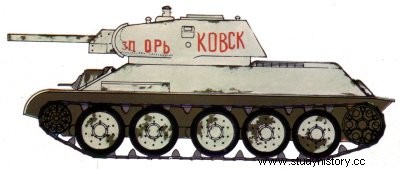
A-20, T-32, T-34, T-34/85, T-34/76A and T-34/76A
country USSR
Type: medium tank.
Crew: 5 men.
Armament: an M1944 Z1S S53 L/51 85 mm cannon; 2 x 7.62 mm DT machine guns.
Shielding: minimum 18mm; max 60mm.
Dimensions:
length (cannon included):7.50 m;
width: 2.92m;
height: 2.39m.
Weight: 32 t.
Ground pressure: 0.80 kg/cm2.
Power to weight: 16.1 bhp.
Engine: V-2-34 12 cyl. water-cooled diesel, developing 507 hp at 1,800 rpm.
Performance:
road speed: 50 km/h;
autonomy: 300km;
vertical obstacle: 0.79m;
straight cut: 2.49m;
slope: 300.
Service time: in the Red Army from 1940. Still used by several countries.
In 1936, the young engineer M.I. Kochkin was transferred to the Comintern plant in Kharkov as the head of the design bureau. This office was dedicated to the modernization of the mixed BT tank (wheels/tracks).
At the beginning of 1937, the plant was commissioned to design a new medium tank, also mixed, called A-20. The creative work was completed in November of this year. The 18t A-20, armed with a 45mm gun, was the first of the so-called “shell-proof” tanks due to its steeply sloped armour, a feature the T-34 would later inherit.
Except for some modifications to the engine elements, the chassis was similar to that of the BT tank. Another version, armed with a 76.2 mm gun, was called A-30.
In the meantime, Kochkin realized that the new tank was being built on the wrong track average according to the mixed formula. The army had rarely used the BT tank without its tracks; however, the fact of equipping the vehicle with the two rolling systems complicated the construction and implied an additional detrimental weight.
Kochkin therefore proposed the creation of an exclusively tracked variant, called A-32 (later T-32) The Supreme Military Council of the USSR agreed to the construction of a prototype.
However, he did not yet reject the mixed formula, awaiting the results of the comparative tests. Completed in Kharkov at the beginning of 1939, the prototypes of the A-20 and T-32 tanks were submitted, during the same year, to the Board of Directors of Armor. This recommended the reinforcement of the armor of the T-32 and the adoption of a more powerful armament.
Kochkin's team set to work and created the definitive version, called T-34. Faced with the seriousness of the international situation, the Higher Military Council decided on December 19, 1939, even before the completion of the prototype, that the T-34 would equip the armored units of the army. Towards the end of January 1940, the first production T-34s, called T-34 06 1940, left the Comintern factory.
At the beginning of February, two of them made, under the personal supervision of Kochkin, an “obstacle course” on the route Kharkov-Moscow-Smolensk-kyiv-Kharkov. In Moscow, on Red Square, the tank was presented to the high command.
In the meantime, Kochkin, suffering from pneumonia, entered the hospital, where he died on September 26, 1940. In June, when the construction plans were completed, the tank was put into serial production. When Kochkin fell ill, his assistant A.A. Morozov took charge of completing the final model.
The T-34 (called Prinadlezhit-Chetverki, or "Thirty-
Four", by the soldiers), was distinguished by the excellent conformation of its armor, which considerably increased its resistance to armor-piercing shells .
Its 76.2 mm long-barreled, rapid-firing gun was also an innovation for tanks of this category.
The new 507 hp V-2 diesel engine (which already equipped the BT7M) reduced the risk of fire while greatly increasing the range of the tank. The modified Christie suspension allowed high speeds, even on difficult terrain; the wide tracks reduced the pressure on the ground to a minimum.
The general design of the tank allowed for rapid construction and simplified maintenance and repairs in the field. You could say that Kochkin's T-34 is the Soviet equivalent of Mitchell's Spitfire. The analogy is even disturbing:the two creators died on the job trying to equip their country with a decisive weapon to achieve victory . By the end of 1940, 115 T-34s had been completed.
Some were sent to Finland to be tested in combat but they arrived there too late to participate in the operations. In June 1941, during the German attack, there were already 1,225 of them. When the battle of Moscow began, 1,853 copies had been delivered to combat units but many of them, of course, had been destroyed in the meantime. . The T-34 received its baptism of fire on June 22, 1941, near Grodno, Belarus. It was a complete surprise for the German army,
who learned to treat this tank with the greatest respect. It was planned to build a copy of it in Germany, but this site turned out to be unfeasible. As a result.
the Germans created their famous Pan tank, whose general Gomes) lion was strongly influenced by that of the 7.34 After the evacuation to the east of the look-alike tank factories. construction of T-34s continued at Itralmash /s'yod (Ural Machine-Building Plant) as well as at a number of secondary factories
Originally, the T-34 was armed with the 76.2 min Modele 1939 L-11 gun, mounted in a rolled and wrought steel sheet turret. In order to speed up production. a new cast turret was soon changed Towards the middle of 1941, the new Modele 401 34 gun was adopted, with a longer barrel and a higher velocity ni bath Many changes were made during production to the T- 34, but the most important was the adoption in the fall of 1943 of the 215 S-53 gun. Thus armed. the tank which had an ammunition load of 55 shells and 2,394 cartridges of 7.62 mm, was called T-34/85 and put into production) from December 15, 1943 At the end of this same year, 283 examples had been built and 11 (XX) more were added the following year Production of the T-34/85 continued until the adoption of the T-54 in the mid-1950s. It was used by other Whou armies in the mid-1960s
